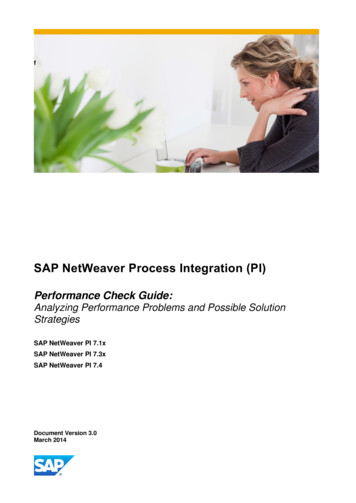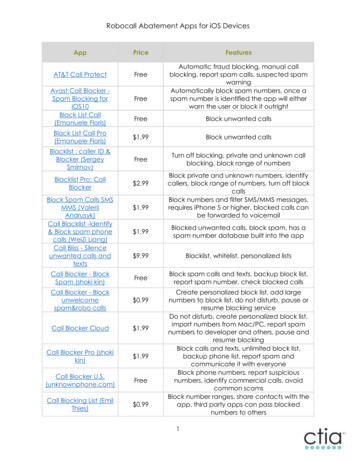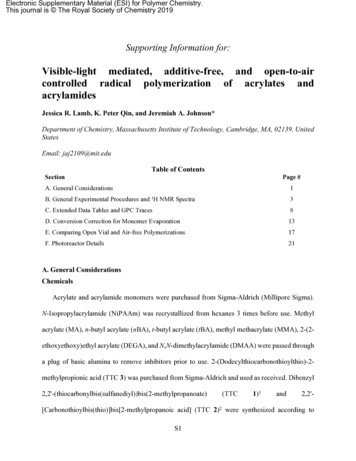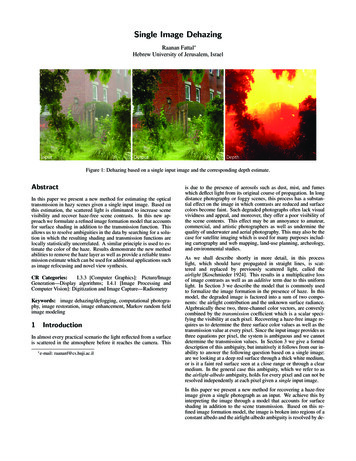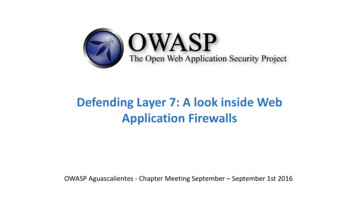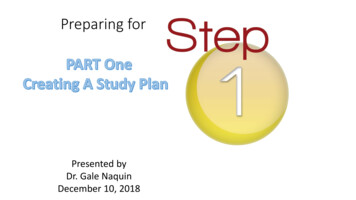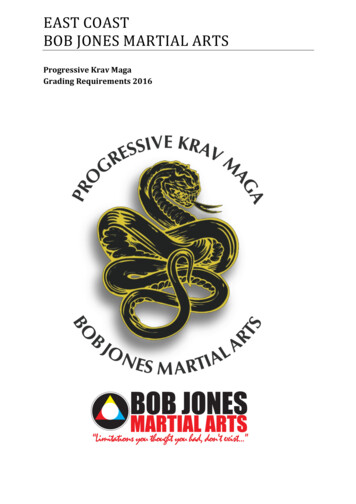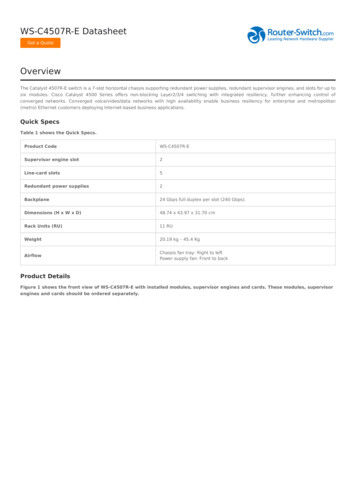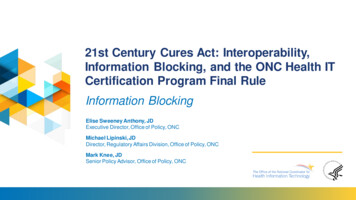
Transcription
21st Century Cures Act: Interoperability,Information Blocking, and the ONC Health ITCertification Program Final RuleInformation BlockingElise Sweeney Anthony, JDExecutive Director, Office of Policy, ONCMichael Lipinski, JDDirector, Regulatory Affairs Division, Office of Policy, ONCMark Knee, JDSenior Policy Advisor, Office of Policy, ONC
2Please Note: The materials contained in this presentation are based on the provisions contained in45 C.F.R. Parts 170 and 171. While every effort has been made to ensure the accuracyof this restatement of those provisions, this presentation is not a legal document. Theofficial program requirements are contained in the relevant laws and regulations. Pleasenote that other Federal, state and local laws may also apply. This communication is produced and disseminated at U.S. taxpayer expense.
3AgendaA. BackgroundB. Framework, Timeline, and TermsC. ExceptionsD. Complaint Process
4Information Blocking – Path to the 21st Century Cures ActIn a 2015 report to Congress,ONC provided a definition ofinformation blocking, ananalysis of the extent to whichthe practice exists in theindustry, and recommendationsto address the issue.ONC continued to engagewith stakeholders andprovided ongoing technicalassistance to Congress.In December 2016, the 21stCentury Cures Act was signedinto law. It included a definitionof information blocking andprovisions for addressinginformation blocking.
5Information Blocking – Path to the Final RuleFollowing theenactment of theCures Act, ONCcontinuously metwith stakeholders.ONC listened toand reviewedcomplaints ofinformationblocking.ONC consultedwith federalagencies, includingthe HHS OIG,HHS OCR, andthe Federal TradeCommission.After release of theONC proposed ruleon March 4, 2019,ONC received over2,000 commentsubmissions. ONCmet with stakeholdersand consulted withfederal agencies.ONC’s final rulereleased onMarch 9, 2020.
6Information Blocking in the 21st Century Cures Act21st Century Cures Act, Section 4004: Defines “information blocking” Authorizes the Secretary to identify, through rulemaking, reasonableand necessary activities that do not constitute information blocking Identifies the HHS Office of Inspector General (OIG) as the HHSoffice to investigate claims of information blocking and providesreferral processes to facilitate coordination with the HHS Office forCivil Rights (OCR) Prescribes penalties for information blocking Charges ONC with implementing a complaint process for reportinginformation blocking, and provides confidentiality protections forcomplaints
7Framework, Timeline,and Terms
8What Makes an Individual or Entity anInformation Blocker?Elements of information blocking Actor regulated by the information blocking provision Involves electronic health information (EHI) Practice is likely to interfere with access, exchange,or use of EHI Requisite knowledge by the actor Not required by law Not covered by an exception
9Consequences of Being an Information Blocker Cures Act prescribes penalties for information blocking Health IT developers of certified health IT, healthinformation networks, and health information exchanges Civil monetary penalties (CMPs) up to 1 million perviolation Health care providers Appropriate disincentives Certification ban (§ 170.581) for health ITdevelopers in violation of the Conditions of Certification Information blocking Condition of Certification (§ 170.401) Public listing of certification bans and terminations
10Compliance Timeline Actors do not have to comply with the information blocking provision until sixmonths after publication of the final rule. Enforcement of information blocking civil monetary penalties (CMPs) will notbegin until established by future rulemaking by OIG. As a result, actors will not besubject to penalties until the CMP rule is final. At a minimum, the timeframe for enforcement will not begin sooner than thecompliance date of the ONC final rule and will depend on when the CMPrules are final. Discretion will be exercised such that conduct that occurs before the CMPrule is finale will not be subject to information blocking CMPs.
11Information Blocking Definition in the Final Rule(a) Information blocking means a practice that—(1) Except as required by law or covered by an exception, is likely to interfere with access, exchange, or useof electronic health information; and(2) If conducted by a health information technology developer, health information network or healthinformation exchange, such developer, network or exchange knows, or should know, that such practice islikely to interfere with access, exchange, or use of EHI; or(3) If conducted by a health care provider, such provider knows that such practice is unreasonable and islikely to interfere with the access, exchange, or use of EHI.(b) Until 24 months after the publication date of the final rule, EHI for purposes of paragraph (a) of thissection is limited to the EHI identified by the data elements represented in the USCDI standard adopted in §170.213.Clarifications from the Proposed Rule Defined “interfere with” to include “prevent” and “materially discourage” Added paragraph (b)
12“Actors” Regulated in the Final RuleHealth CareProvidersHealth ITDevelopers ofCertified Health ITHealth InformationNetworks (HIN)/Health InformationExchanges (HIE)
13Health Care ProvidersWho are they? hospitalskilled nursing facilitynursing facilityhome health entity or otherlong term care facilityhealth care cliniccommunity mental health centerrenal dialysis facilityblood centerambulatory surgical emergency medical servicesprovider federally qualified health center group practice pharmacist pharmacy laboratory physician practitioner rural health clinic provider operated by, or undercontract with, the Indian HealthService or by an Indian tribe,tribal organization, or urban Indianorganization “covered entity” under certainstatutory provisions therapist any other category of health carefacility, entity, practitioner, orclinician determined appropriate bythe Secretary ambulatory surgical centerFinalized as proposed with the the same meaning as “health care provider” in 42 U.S.C. 300jj.
14Health IT Developers of Certified Health ITWho are they?An individual or entity, other than a health care provider that self-develops health IT for itsown use, that develops or offers health information technology and which has, at the time itengages in a practice that is the subject of an information blocking claim, one ormore Health IT Modules certified under a program for the voluntary certification of healthinformation technology that is kept or recognized by the National Coordinator.Changes and Clarifications from the Proposed Rule Expressly excludes “self-developers” from the definition Does not extend beyond the time the developer no longer hashealth IT certified under the Program
15Health Information Networks & ExchangesWho are they?An individual or entity that determines, controls, or has the discretion to administer anyrequirement, policy, or agreement that permits, enables, or requires the use of anytechnology or services for access, exchange, or use of EHI:1. Among more than two unaffiliated individuals or entities (other than the individualor entity to which this definition might apply) that are enable to exchange with eachother; and2. That is for a treatment, payment, or health care operations purpose, as such termsare defined in 45 CFR 164.501 regardless of whether such individuals or entities aresubject to the requirements of 45 CFR parts 160 and 164.Changed in Four Ways
16Electronic Health InformationWhat does it mean?Electronic protected health information (ePHI) as the term is definedfor HIPAA in 45 CFR 160.103 to the extent that the ePHI would beincluded in a designated record set (DRS) as defined in 45 CFR164.501 (other than psychotherapy notes as defined in 45 CFR 164.501or information compiled in reasonable anticipation of, or for use in, a civil,criminal, or administrative action or proceeding), regardless of whetherthe actor is a covered entity as defined in 45 CFR 160.103.Changes and Clarifications from the Proposed Rule Focused definition on ePHI included in a DRS. This definition does not expressly include or exclude price information. To the extentthat ePHI includes price information and is included in a DRS, it would beconsidered EHI.
17“Interfere with” or “Interference”What is it?Interfere with or interference means to prevent, materially discourage, or otherwiseinhibit. Publication of “FHIR service base URLs” (sometimes also referred to as “FHIRendpoints”) - A FHIR service base URL cannot be withheld by an actor as it (just like many othertechnical interfaces) is necessary to enable the access, exchange, and use of EHI. Delays - An actor’s practice of slowing or delaying access, exchange, or use of EHI could constitutean interference and implicate the information blocking provision. Costs for Electronic Access by Patients/Individuals - An actor’s practice of charging anindividual, their personal representative, or another person or entity designated by the individual forelectronic access to the individual’s EHI would be inherently suspect under an information blockingreview.
18“Interfere with” or “Interference”What is it not?Interfere with or interference means to prevent, materially discourage, or otherwiseinhibit. Business Associate Agreements (BAAs) – Actors are not required to violate BAAs orassociated service level agreements. However, a BAA or its associated service levelagreements must not be used in a discriminatory manner by an actor to forbid or limitdisclosures that otherwise would be permitted by the Privacy Rule. Educate Patients about Privacy and Security Risks of Apps and 3rd Parties – Actorsmay provide patients with information that: Focuses on any current privacy and/or security risks posed by the technology or the third-partydeveloper of the technology; Is factually accurate, unbiased, objective, and not unfair or deceptive; and Is provided in a non-discriminatory manner.
19Knowledge StandardHealth Care Providers“ knows that such practice isunreasonable and is likely tointerfere with the access, exchangeor use of electronic healthinformation .”Health IT Developers of CertifiedHealth IT and HINs/HIEs“ knows, or should know, thatsuch practice is likely to interferewith the access, exchange or use ofelectronic health information .”
20Required by LawWhat does it mean? Refers specifically to interferences with access, exchange, oruse of EHI that are explicitly required by state or federal law. Distinguishes between interferences that are “required by law”and those engaged in pursuant to a privacy law, but which arenot “required by law.”Clarification from the Proposed RuleFederal and state law includes: Statutes, regulations, court orders, and bindingadministrative decisions or settlements, such as (at theFederal level) those from the FTC or the Equal EmploymentOpportunity Commission (EEOC) Tribal laws, as applicable
21Exceptions
22Overview of the Exceptions On behalf of HHS, ONC has defined eightexceptions that offer actors certainty that, whentheir practices with respect to accessing,exchanging, or using EHI meet the conditions ofone or more exceptions, such practices will not beconsidered information blocking. An actor’s practice that does not meet theconditions of an exception will not automaticallyconstitute information blocking. Instead such practices will be evaluated on acase-by-case basis to determine whetherinformation blocking has occurred.
23Overview of the ExceptionsThe eight exceptions are divided into two categories:Exceptions for not fulfilling requests toaccess, exchange, or use EHI1. Preventing Harm2. Privacy3. Security4. Infeasibility5. Health IT PerformanceExceptions for procedures for fulfillingrequests to access, exchange, or use EHI6. Content and Manner7. Fees8. Licensing
24Preventing Harm ExceptionOverviewIt will not be information blocking for an actor to engage in practices thatare reasonable and necessary to prevent harm to a patient or anotherperson, provided certain conditions are met.To satisfy this exception:The actor must hold a reasonable belief that the practice will substantiallyreduce a risk of harm and the practice must be no broader than necessary Implement a QualifyingImplement a QualifyingThe practicemust Policysatisfy at least one conditionfrom pe of risk, type of harm, and implementation basis The practice must satisfy the condition concerning a patient right torequest review of an individualized determination of risk of harmObjectiveThis exception recognizes thatthe public interest in protectingpatients and other personsagainst unreasonable risks ofharm can justify practices that arelikely to interfere with access,exchange, or use of EHI.
25Privacy ExceptionOverviewIt will not be information blocking if an actor does not fulfill arequest to access, exchange, or use EHI in order to protectan individual’s privacy, provided certain conditions are met.To satisfy this exception,an actor’s privacy-protective practice must:Satisfy at least one sub-exception Meet all conditions applicableto a sub-exception being relied uponObjectiveThis exception recognizes that if anactor is permitted to provide access,exchange, or use of EHI under aprivacy law, then the actor shouldprovide that access, exchange, oruse. However, an actor should notbe required to use or disclose EHI ina way that is prohibited under stateor federal privacy laws.
26Security ExceptionOverviewIt will not be information blocking for an actor to interfere withthe access, exchange, or use of EHI in order to protect thesecurity of EHI, provided certain conditions are met.To satisfy this exception,an actor’s security-related practice must:Satisfy threshold conditions Implement a QualifyingOrganizational Security PolicyORImplement a QualifyingSecurity DeterminationObjectiveThis exception is intended tocover all legitimate securitypractices by actors, but does notprescribe a maximum level ofsecurity or dictate a one-sizefits-all approach.
27Infeasibility ExceptionOverviewIt will not be information blocking if an actor does not fulfill arequest to access, exchange, or use EHI due to the infeasibilityof the request, provided certain conditions are met.To satisfy this exception, an actor must:Demonstrate that the practice meets one of the conditions foruncontrollable events, segmentation, or infeasibility under thecircumstances Provide written response, within 10 business days of receipt ofthe request, with the reason(s) why the request is infeasibleObjectiveThis exception recognizes thatlegitimate practical challenges maylimit an actor’s ability to comply withrequests for access, exchange, oruse of EHI. An actor may not have—and may be unable to obtain—therequisite technological capabilities,legal rights, or other meansnecessary to enable access,exchange, or use.
28Health IT Performance ExceptionOverviewIt will not be information blocking for an actor to take reasonable andnecessary measures to make health IT temporarily unavailable or todegrade the health IT's performance for the benefit of the overallperformance of the health IT, provided certain conditions are met.To satisfy this exception, the practice must meetone of the following conditions:Maintenance and improvementsORAssured level of performanceORPractices that prevent harm / security-related practicesObjectiveThis exception recognizes that forhealth IT to perform properly andefficiently, it must be maintained, and insome instances improved, which mayrequire that health IT be taken offlinetemporarily. Actors should not bedeterred from taking reasonable andnecessary measures to make health ITtemporarily unavailable or to degrade thehealth IT’s performance for the benefit ofthe overall performance of health IT.
29Content and Manner ExceptionOverviewObjectiveIt will not be information blocking for an actor to limit thecontent of its response to a request to access, exchange, oruse EHI or the manner in which it fulfills a request, providedcertain conditions are met.To satisfy this exception,an actor must meet both of these conditions:Content condition Manner conditionThis exception provides clarity andflexibility to actors concerning therequired content of an actor’sresponse to a request to access,exchange, or use EHI and themanner in which the actor may fulfillthe request. It supports innovationand competition by allowing actors tofirst attempt to reach and maintainmarket negotiated terms for theaccess, exchange, and use of EHI.
30Content and Manner ExceptionContent Condition1. Up to 24 months after the publication date of the final rule, an actormust respond to a request to access, exchange, or use EHI with, at aminimum, the EHI identified by the data elements represented in theUSCDI standard.2. On and after 24 months after the publication date of the final rule, anactor must respond to a request to access, exchange, or use EHI withEHI as defined in § 171.102.
31Content and Manner ExceptionManner Condition – Any Manner Requested An actor must fulfill a request in any manner requested unless the actor is:1. Technically unable to fulfill the request in a manner requested; or2. Cannot reach agreeable terms with the requestor to fulfill the request. If an actor fulfills a request in any manner requested, the actor is not requiredto comply with the Fees or Licensing Exception.
32Content and Manner ExceptionManner Condition – Alternative Manner If an actor responds in an alternative manner, the actor must fulfill the request withoutunnecessary delay in the following order of priority, only proceeding to the next consecutiveparagraph if technically unable to fulfill the request in that manner:1. Using technology certified to standard(s) adopted in Part 170 that is specified by therequestor.2. Using content and transport standards specified by the requestor and published by: Federal Government; or Standards developing organization accredited by the American National StandardsInstitute.3. Using an alternative machine-readable format, including the means to interpret the EHI,agreed upon with the requestor.
33Fees ExceptionOverviewIt will not be information blocking for an actor to chargefees, including fees that result in a reasonable profitmargin, for accessing, exchanging, or using EHI,provided certain conditions are met.To satisfy this exception, the practice must:Meet basis for fees condition Not be specifically excluded Comply with Assurances and/or API Conditions of Certification, as applicableObjectiveThis exception enables actors tocharge fees related to thedevelopment of technologies andprovision of services that enhanceinteroperability, while not protectingrent-seeking, opportunistic fees, andexclusionary practices that interferewith access, exchange, or use of EHI.
34Licensing ExceptionOverviewIt will not be information blocking for an actor to licenseinteroperability elements for EHI to be accessed,exchanged, or used, provided certain conditions are met.To satisfy this exception, the practice must:Meet the negotiating a license conditions Meet the licensing conditions Meet the additional conditions relating to the provision ofinteroperability elementsObjectiveThis exception allows actorsto protect the value of theirinnovations and chargereasonable royalties in orderto earn returns on theinvestments they have madeto develop, maintain, andupdate those innovations.
35Complaint Process
36Complaint Process The Cures Act directs the National Coordinator to implement a standardizedprocess for the public to submit reports on claims of information blocking. We will implement and evolve the complaint process by building on existingmechanisms, including the process for providing feedback and expressingconcerns about health IT that is currently available atwww.healthit.gov/healthit-feedback. For additional information about submitting an information blocking complaintor about information blocking general, please see our final rule website andmaterials at www.healthit.gov/curesrule.
37Protection from Disclosure of InformationExcerpt from 21st Century Cures ActAny information received byONC in connection with aclaim or suggestion ofpossible informationblocking and that couldreasonably be expected tofacilitate identification of thesource of the informationwould fall under protectionsin section 3022(d)(2) of thePublic Health Service Act.SEC. 4004. INFORMATION BLOCKING.Subtitle C of title XXX of the Public Health Service Act (42 U.S.C. 300jj–51 et seq.) is amendedby adding at the end the following:‘SEC. 3022. INFORMATION BLOCKING.“(d) ADDITIONAL PROVISIONS (2) PROTECTION FROM DISCLOSURE OF INFORMATION.—Any information that isreceived by the National Coordinator in connection with a claim or suggestion of possibleinformation blocking and that could reasonably be expected to facilitate identification ofthe source of the information—“(A) shall not be disclosed by the National Coordinator except as may be necessaryto carry out the purpose of this section;“(B) shall be exempt from mandatory disclosure under section 552 of title 5, UnitedStates Code, as provided by subsection (b)(3) of such section; and“(C) may be used by the Inspector General or Federal Trade Commission forreporting purposes to the extent that such information could not reasonably be expectedto facilitate identification of the source of such information.
38Please visitwww.healthit.gov/curesrule View the Final Rule Fact Sheets Upcoming Webinar Schedule Previously Recorded Webinars Additional Resources
Phone: 202-690-7151Contact ONCHealth IT Feedback ck-formTwitter: @onc healthITLinkedIn: Search “Office of the NationalCoordinator for Health Information Technology”Subscribe to our weekly eblastat healthit.gov for the latest updates!
Information Blocking Definition in the Final Rule (a) Information blocking means a practice that— (1) Except as required by law or covered by an exception, is likely to interfere with access, exchange, or use of electronic health information; and (2) If conducted by a health information technology develop

